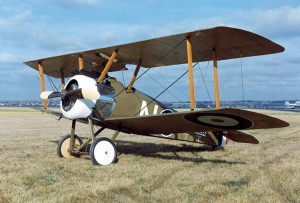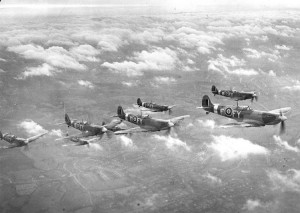Royal Air Force 100
Friday, March 30th, 2018March 30, 2018
On April 1, 1918, 100 years ago this Sunday, the United Kingdom’s Royal Air Force (RAF) became the world’s first national air force independent of an army or navy. The RAF is responsible for most of the United Kingdom’s military air operations. The RAF has long been one of the world’s most advanced and powerful air forces. The RAF centenary—celebrated as RAF100—is being marked by special activities and events throughout the United Kingdom from April through November 2018.

The Sopwith Camel, seen here at the National Museum of the United States Air Force in Dayton, Ohio, was an early famous fighter plane of the Royal Air Force. Credit: U.S. Air Force
A gala concert will launch RAF100 at London’s Royal Albert Hall on March 31. On April 1, a Centenary Baton Relay begins at London’s Royal Courts of Justice and will run through historic RAF sites for 100 days, returning to London on July 10 for the Horse Guards Parade. That same day, a centenary service will be held at Westminster Abbey followed by a parade and flypast of old and new RAF planes over Buckingham Palace. The RAF100 Aircraft Tour will be bring historic warplanes to such U.K. cities as Birmingham, Cardiff, Glasgow, London, and Manchester. Air shows featuring RAF aircraft will take place throughout the summer and special exhibitions will feature at the RAF Museum in London and its satellites in other cities.
The United Kingdom formed its first air force, the Royal Flying Corps (RFC), in 1912. It was part of the British Army. A separate Royal Naval Air Service (RNAS) was formed in 1914. Early in World War I (1914-1918), RFC aircraft were used mainly for reconnaissance (information gathering) and for directing artillery (heavy gun) attacks. RNAS aircraft mainly hunted German submarines and airships. Both services soon developed swift new fighter planes, called scouts at the time, for air-to-air combat. Famous British fighters included the Royal Aircraft Factory S.E.5 and the Sopwith Camel. British bombers, such as the Airco DH4 and DH9, attacked enemy ground targets later in the war. On April 1, 1918, the RFC and RNAS merged to form the Royal Air Force.
In the 1920’s, RAF warplanes flew missions in the Middle East, India, and North Africa. In the late 1930’s, the RAF expanded to keep pace with Germany’s air force. In 1939, the Royal Navy took control of the RAF’s Fleet Air Arm.

Royal Air Force Supermarine Spitfires patrol the skies above the United Kingdom during World War II. Credit: AFHRA
Early in World War II (1939-1945), the RAF lost hundreds of aircraft and crew to German flyers over Belgium and France. The RAF recovered, however. The force repelled repeated German air attacks in the 1940 Battle of Britain. The battle made legends of two British planes—the Hawker Hurricane and Supermarine Spitfire—as well as the pilots who flew them. RAF bombers—most famously the four-engine Avro Lancaster—flew thousands of missions against Germany and occupied Europe. RAF air squadrons also played important roles in North Africa, Southeast Asia, and the Pacific. A number of non-Britons served in the RAF. Flyers came from several countries, including Australia, Canada, Czechoslovakia, New Zealand, Poland, South Africa, and the United States.
In the 1950’s, RAF aircraft supported military operations in Cyprus, Egypt, Kenya, Malaysia, and elsewhere. During part of the Cold War, RAF warplanes armed with nuclear weapons helped deter (discourage) a Soviet attack on the United Kingdom or its allies. The Cold War was an intense rivalry between Communist and non-Communist nations between 1945 and 1991.
RAF warplanes—including the Harrier ground attack aircraft—played important roles during the Falklands War of 1982. RAF aircraft also were active during the Persian Gulf War of 1991, the Afghanistan War (2001-2014), and the Iraq War (2003-2011). The RAF has taken part in numerous North Atlantic Treaty Organization (NATO) combat and relief missions.



